The study of women's history in the Indian subcontinent has been a major scholarly and popular field, with many scholarly books and articles, museum exhibits, and courses in schools and universities.
| Part of a series on |
| Women in society |
|---|
 |
The study of women's history in the Indian subcontinent has been a major scholarly and popular field, with many scholarly books and articles, museum exhibits, and courses in schools and universities.

Women during the Vedic period enjoyed high status with men in all aspects of life. Works by ancient Indian grammarians such as Patanjali and Katyayana suggest that women were educated in the early Vedic period. [1] [2] [3] Rig Vedic verses suggest that women married at a mature age and were probably free to select their own husbands in a practice called swayamvar or through Gandharva marriage. [4] The Rig Veda and Upanishads mention several women sages and seers, notably Gargi Vachaknavi and Maitreyi (c. 7th century BCE). [5]
Originally, women were allowed to undergo initiation and study the Vedas. In the Dharmasutra of Hathras, it is mentioned that:
In Mahabharata, the story of Draupadi's marriage to 5 men is a case in point. This pointed to the fact that polygamy was matched with polyandry during the Vedic era. Women could select their husbands in an assembly called swayamwar. In this practice, the father of the woman would invite all the men and the woman would select one, and marry him while the court watched.
Also, in the Puranas, every God was shown in consort of their wives, Vishnu with Lakshmi and Shiva with Parvati). Idols of god and goddesses were depicted with importance to both genders. Separate temples were set up for goddesses, and within each temple, goddesses were treated and worshipped with as much care and devotion as the gods were. There are also specific practices that endure to this day, in terms of preference of worship.
The book Hindu Female Deities as a resource for contemporary rediscovery of the Goddess by Gross Rita.M, 1989, says:
"According to some scholars the positive constructions of femininity found in goddess imagery and in the related imagery of the virangana or heroic woman have created a cognitive framework, for Hindus to accept and accommodate powerful female figures like "Indira Gandhi and Phoolan Devi, The same would not have been possible in Western religious traditions"
Even in the practice of Homa (ritual involving fire, and offerings to fire), every mantra or Shloka is addressed to Swaha, the wife of Agni, instead of Agni himself. Devi Bhagavata Purana: 9.43, says that all requests to Agni had to be made through his wife only:
"O Goddess, Let yourself become the burning power of fire; who is not able to burn anything without thee. At the conclusion of any mantra, whoever taking thy name (Svaha), will pour oblations in the fire, he will cause those offerings to go directly to the gods. Mother, let yourself, the repository of all prosperity, reign over as the lady of his (fire's) house."
This aspect of Swaha as Agni's wife is mentioned in Mahabharata, Brahmavantara Purana, Bhagavatha Purana as various hymns.

In the 6th or 5th century BCE, Queen Mṛgāvatī (in Sanskrit), or Migāvatī (in Prakrit) of the Vatsa mahajanapada ruled as regent while her son Udayana was either a minor or held captive by a rival king, and she earned "the admiration of even experienced ministers." [6] [7]
Apastamba sutra (c. 4th century BCE) [8] [3] captures some prevalent ideas of the role of women during the post Vedic ages. The Apastamba Sutra shows the elevated position of women that existed during the 4th century BCE:
A man is not allowed to abandon his wife (A 1.28.19).
He permits daughters to inherit (A 2.14.4). There can be no division of property between a husband and a wife, because they are linked inextricably together and have joint custody of the property (A 2.29.3). Thus, a wife may make gifts and use the family wealth on her own when her husband is away (A 2.12.16–20).
Women are upholders of traditional lore, and Āpastamba tells his audience that they should learn some customs from women (A 2.15.9; 2.29.11).

In the Gupta period instances are not rare of women participating in an administrative job. Chandragupta I, founder of the Gupta Empire, ruled the kingdom jointly with his queen Kumara Devi. [9] Prabhavatigupta was the daughter of Chandra Gupta II of the Gupta Empire and the wife of Rudrasena II of the Vakataka dynasty, and performed administrative duties in her kingdom. [7] Instances of women of the upper classes extending their phase of activities beyond the domestic circle are provided by the queen and queens regent in Kashmir, Rajasthan, Orissa and Andhra. Institutions were established for co-education. In the work called Amarkosh written in the Gupta era names of the teachers and professors are there and they belonged to the female sex.
In the 2nd century BCE, Queen Nayanika (or Naganika) was the ruler and military commander of the Satavahana Empire of the Deccan region (south-central India). [7] Another early female ruler in South Asia was Queen Anula of Anuradhapura (Sri Lanka, 1st century BCE).
Queen Orrisa assumed regency when her son died in the late ninth century and immediately involved herself in military adventuring. Queen Kurmadevi of Mevad commanded her armies on the battlefield in the late twelfth century. Queen Didda of Kashmir ruled as full sovereign for twenty-two years, and Queen Jawahirabi fought and died at the head of her army.
In Sri Lanka, Queen Sugula led her armies against the southern king, her nephew. When pressed by the royal forces, she guided her forces into the mountains, where she built a number of forts. Sugula held out against the king's army for ten years and is remembered in Sri Lankan history as "Sugula, the rebel queen fearless".
Rudrama Devi was a monarch of the Kakatiya dynasty in the Deccan Plateau with capital at Warangal of present-day Telangana from 1263 until her death. She was one of the few women to rule as monarch in the Indian subcontinent and promoted a male image in order to do so. [10] Akka Mahadevi was a prominent figure of the Veerashaiva Bhakti movement of the 12th century Karnataka. Her Vachanas in Kannada, a form of didactic poetry, are considered her most notable contribution to Kannada Bhakti literature. While, a few centuries later, Meera in northern India, became a leading Hindu mystic poet of the Bhakti movement. [11]
The position of Indian women in society deteriorated during this period. [12] [13] Jauhar which became a custom among Rajputs was performed when they were faced with invaders like Turco-Afghans from the 11th century to avoid being enslaved and lose their honor. [14] [15] During the conquest of Sindh by Muhammad bin Qasim, Rani Bai and other Rajput women had performed the jauhar. [16] [17] It was committed thrice, in Chittor Fort alone, by many of the wives and children of the Rajput soldiers who died in battles at Chittorgarh Fort. The first time was led by Rani Padmini, wife of Ratnasimha, who was killed in the battle in 1303, and later, by Rani Karnavati in 1537. [18]
The zenana was a Persian tradition brought in by the invading Muslims. Although originally only a feature of the courts of Muslim dynasties, it was also adopted by Hindu royal families. While separate spaces for women sometimes did exist in the ancient period, they didn't become a norm until the Muslim period. Under Akbar, there was a marked focus on secluding women and the creation of harems. This policy of Mughals was also emulated later by others like Chakma Raj and the Sikh kingdoms in Punjab. [19] [20]
The rights of a Muslim woman were impacted by the custom of hijab or purdah in Persian. Despite this, women took part in arts, writing, rites and rode horses while their habits sometimes swayed from the opinion of the ulama . The hijab and burqah was a practice in West Asia and became a part of regal practice under the Delhi Sultanate and Mughal Empire. The practice of purdah was later emulated by Hindus in North India. [21] The queens often played a part in imperial politics behind the scene. In South India, some communities who adopted Islam have continued their ancestral matrilinear traditions like the Mappila. Ibn Battuta in the Muslim principality of Hannaur, witnessed 13 schools teaching Muslim women. Both genders were taught by mullahs, however, lower-classes were more uneducated. [22]
The observance of purdah was not strict among the Turks. Among the reasons considered for its use are that it represented an elite status during the Muslim period and was also used to guard women and men from looking at each other with lust, and as during this period the rulers and nobility sometimes engaged in debauchery and excesses. [23] [24] Muslim nobility often engaged in lustful debauchery, concubines were not regarded as a shameful act, but a status of wealth. [25] However, purdah was imposed by sultan Firuz Tughlaq. Akbar made it a rule that those women roaming without a veil be made a prostitute. He also directed that they should live within their house and travel under the supervision of a male. The upper-class women were better-off due to private education and entertainment. The purdah system became weaker as the Mughal empire declined. [26] However, there were cases of women often becoming prominent in the fields of politics, literature, education, and religion also during this period. [12] Razia Sultana (1205–1240) became the only woman monarch to have ever ruled Delhi.
The Gond Rani Durgavati (1524–1564) ruled for fifteen years before losing her life in a battle with Mughal emperor Akbar's general Asaf Khan in 1564. Chand Bibi defended Ahmednagar against the powerful Mughal forces of Akbar in the 1590s. Jehangir's wife Nur Jehan effectively wielded imperial power, and was recognised as the real power behind the Mughal throne. The Mughal princesses Jahanara and Zebunnissa were well-known poets, and also influenced the ruling powers. Abbakka Chowta was the first Tuluva Queen of Ullal who fought the Portuguese in the latter half of the 16th century. Shivaji's mother, Jijabai, was queen regent because of her ability as a warrior and an administrator. Tarabai was another female Maratha ruler. Keladi Chennamma fought against Bijapur Sultanate and defying Mughal emperor Aurangzeb. Onake Obavva was a woman who fought the forces of Hyder Ali single-handedly with a pestle (Onake) [27] in the kingdom of Chitradurga. Mai Sukhan, with her small Sikh forces, strongly defended the town of Amritsar against external forces. While, Velu Nachiyar, was one of the earliest Indian queens to fight against the British colonial power in India. Kittur Chennamma was the Rani of Kittur, who led an armed force against the British East India Company in 1824 in defiance of the doctrine of lapse in an attempt to maintain Indian control over the region, but was defeated in the third war and died imprisoned. In South India, many women administered villages, towns, and divisions, and ushered in new social and religious institutions. [28] Lakshmibai, the Rani of Maratha-ruled Jhansi, one of the principal leaders of the rebellion who earlier had lost her kingdom as a result of the Doctrine of Lapse.
During the British Raj, many reformers such as Ram Mohan Roy, Dayanand Saraswati, Ishwar Chandra Vidyasagar and Jyotirao Phule fought for the betterment of women. Peary Charan Sarkar, a former student of Hindu College, Calcutta and a member of "Young Bengal", set up the first free school for girls in India in 1847 in Barasat, a suburb of Calcutta (later the school was named Kalikrishna Girls' High School).
While this might suggest that there was no positive British contribution during the Raj era, that is not entirely the case. Missionaries' wives such as Martha Mault née Mead and her daughter Eliza Caldwell née Mault are rightly remembered for pioneering the education and training of girls in south India. This practice was initially met with local resistance, as it flew in the face of tradition. Raja Rammohan Roy's efforts led to the abolition of Sati under Governor-General William Cavendish-Bentinck in 1829. Ishwar Chandra Vidyasagar's crusade for improvement in the situation of widows led to the Widow Remarriage Act of 1856. Many women reformers such as Pandita Ramabai also helped the cause of women.
Kittur Chennamma, queen of the princely state Kittur in Karnataka, [31] led an armed rebellion against the British in response to the Doctrine of lapse. Rani Lakshmi Bai, the Queen of Jhansi, led the Indian Rebellion of 1857 against the British. She is now widely considered as a national hero. Begum Hazrat Mahal, the co-ruler of Awadh, was another ruler who led the revolt of 1857. She refused deals with the British and later retreated to Nepal. The Begums of Bhopal were also considered notable female rulers during this period. They were trained in martial arts. Chandramukhi Basu, Kadambini Ganguly and Anandi Gopal Joshi were some of the earliest Indian women to obtain a degree.
In 1917, the first women's delegation met the Secretary of State to demand women's political rights, supported by the Indian National Congress. The All India Women's Education Conference was held in Pune in 1927, it became a major organisation in the movement for social change. [32] [33] In 1929, the Child Marriage Restraint Act was passed, stipulating fourteen as the minimum age of marriage for a girl. [32] [34] [ full citation needed ] Mahatma Gandhi, himself a victim of child marriage at the age of thirteen, he later urged people to boycott child marriages and called upon young men to marry child widows. [35]
Women have served as heads of state and government in India, Sri Lanka, Pakistan and Bangladesh. This includes:

Anatomically modern humans first arrived on the Indian subcontinent between 73,000 and 55,000 years ago. The earliest known human remains in South Asia date to 30,000 years ago. Sedentariness began in South Asia around 7000 BCE; by 4500 BCE, settled life had spread, and gradually evolved into the Indus Valley Civilisation, which flourished between 2500 BCE and 1900 BCE in present-day Pakistan and north-western India. Early in the second millennium BCE, persistent drought caused the population of the Indus Valley to scatter from large urban centres to villages. Indo-Aryan tribes moved into the Punjab from Central Asia in several waves of migration. The Vedic Period was marked by the composition of their large collections of hymns (Vedas). The social structure was stratified via the varna system, which persists till this day though highly evolved. The pastoral and nomadic Indo-Aryans spread from the Punjab into the Gangetic plain. Around 600 BCE, a new, interregional culture arose; then, small chieftaincies (janapadas) were consolidated into larger states (mahajanapadas). A second urbanisation took place, which came with the rise of new ascetic movements and religious concepts, including the rise of Jainism and Buddhism. The latter was synthesised with the preexisting religious cultures of the subcontinent, giving rise to Hinduism.

The history of Pakistan preceding the country's independence in 1947 is shared with that of Afghanistan, India, and Iran. Spanning the northwestern expanse of the Indian subcontinent and the eastern borderlands of the Iranian plateau, the region of present-day Pakistan served both as the fertile ground of a major civilization and as the gateway of South Asia to Central Asia and the Near East.

Sati was a historical practice in Hindu communities in which a widow sacrifices herself by sitting atop her deceased husband's funeral pyre. Although it is debated whether it received scriptural mention in early Hinduism, it has been linked to related Hindu practices in the Indo-Aryan-speaking regions of India. Greek sources from around 300 BCE make isolated mention of sati, but it probably developed into a real fire sacrifice in the medieval era within the northwestern Rajput clans to which it initially remained limited, to become more widespread during the late medieval era.

Jauhar, sometimes spelled Jowhar or Juhar, was a Hindu Rajput practice of mass self-immolation by females, both adults and children, in the Indian subcontinent to avoid capture, enslavement and rape by Turko-Persian Islamic invaders when facing certain defeat during a war. Some reports of jauhar mention women committing self-immolation along with their children. This practice was historically observed in the northwest regions of India, with most famous jauhars in recorded history occurring during wars between Hindu Rajput kingdoms in Rajasthan and the opposing Turko-Persian Muslim armies. Jauhar was only performed during war, usually when there was no chance of victory. The term jauhar often connotes jauhar-immolation. Jauhar involved Hindu Rajput women committing suicide with their children and valuables in a massive fire, in order to avoid capture and abuse in the face of inescapable military defeat. At the same time or shortly thereafter, the men would ritualistically march to the battlefield expecting certain death, which in the regional tradition is called saka. This practice was intended to show that those committing it valued their honor more highly than their lives.

The history of Kashmir is intertwined with the history of the broader Indian subcontinent in South Asia with influences from the surrounding regions of Central, and East Asia. Historically, Kashmir referred to only the Kashmir Valley of the western Himalayas. Today, it denotes a larger area that includes the Indian-administered union territories of Jammu and Kashmir and Ladakh, the Pakistan-administered territories of Azad Kashmir and Gilgit-Baltistan, and the Chinese-administered regions of Aksai Chin and the Trans-Karakoram Tract.
Rajput, also called Thakur, is a large multi-component cluster of castes, kin bodies, and local groups, sharing social status and ideology of genealogical descent originating from the Indian subcontinent. The term Rajput covers various patrilineal clans historically associated with warriorhood: several clans claim Rajput status, although not all claims are universally accepted. According to modern scholars, almost all Rajput clans originated from peasant or pastoral communities.
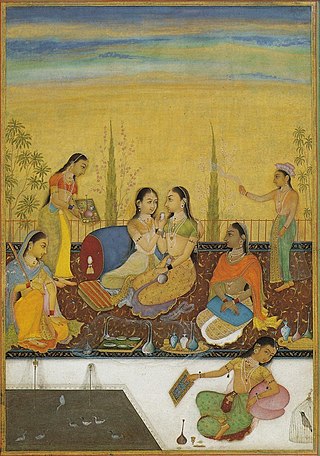
Zenana literally meaning "of the women" or "pertaining to women", in the Persian language contextually refers to the part of a house belonging to a Muslim, Sikh, or Hindu family in the Indian subcontinent, which is reserved for the women of the household. The zenana was a product of Indo-Islamic culture and was commonly found in aristocratic Muslim families. Due to prolonged interactions between Hindus and Muslims, upper-class Hindu households, inclined to imitate elite cultural trends, also embraced these designated spaces. The zenana were the inner rooms of a house where the women of the family lived and where men and strangers were not allowed to enter. The outer apartments for guests and men are called the mardana. Conceptually in those that practise purdah, it is the equivalent in the Indian subcontinent of the harem.
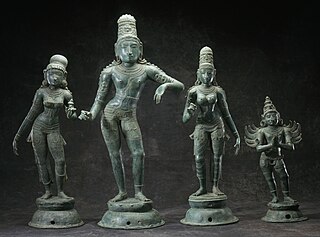
The history of Hinduism covers a wide variety of related religious traditions native to the Indian subcontinent. It overlaps or coincides with the development of religion in the Indian subcontinent since the Iron Age, with some of its traditions tracing back to prehistoric religions such as those of the Bronze Age Indus Valley Civilisation. Hinduism has been called the "oldest religion" in the world, but scholars regard Hinduism as a relatively recent synthesis of various Indian cultures and traditions, with diverse roots and no single founder. This Hindu synthesis emerged after the Vedic period, between c. 500-200 BCE and c. 300 CE, in or after the period of the Second Urbanisation, and during the early classical period of Hinduism. It flourished in the medieval period, with the decline of Buddhism in India.

The Muslim conquests in the Indian subcontinent mainly took place between the 13th and the 18th centuries. Earlier Muslim conquests in the subcontinent include the invasions which started in the northwestern subcontinent, especially the Umayyad campaigns during the 8th century. Mahmud of Ghazni, Sultan of the Ghaznavid Empire, preserved an ideological link to the suzerainty of the Abbasid Caliphate and invaded vast parts of Punjab and Gujarat during the 11th century. After the capture of Lahore and the end of the Ghaznavids, the Ghurid ruler Muhammad of Ghor laid the foundation of Muslim rule in India in 1192. In 1202, Bakhtiyar Khalji led the Muslim conquest of Bengal, marking the easternmost expansion of Islam at the time.

Mariam-uz-Zamani ;, commonly known by the misnomer Jodha Bai, was the chief consort and principal Hindu wife as well as the favourite wife of the third Mughal emperor, Akbar. She was also the longest-serving Hindu empress of the Mughal Empire with a tenure of forty-three years (1562–1605).
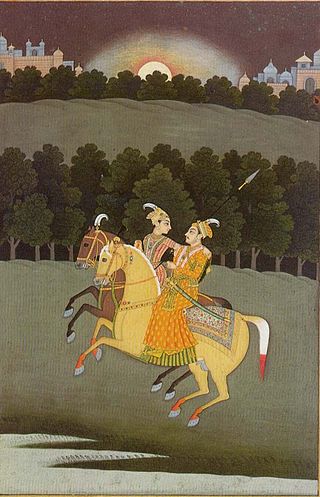
Rani Roopmati (kavi roopmati) was a Poet queen of Mandu and the consort of the Sultan of Malwa, Baz Bahadur. Roopmati features prominently in the folklores of Malwa, which often describe the romance of the Sultan and his consort.
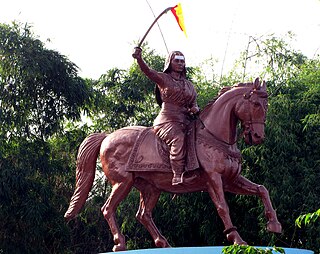
Kittur Chennamma was the Indian Queen of Kittur, a former princely state in present-day Karnataka. She led an armed resistance against the British East India Company, in defiance of the Paramountcy, in an attempt to retain control over her dominion. She defeated the Company in the first revolt, but died as a prisoner of war after the second rebellion. As one of the first and few female rulers to lead kittur forces against British colonisation, she continues to be remembered as a folk hero in Karnataka, she is also an important symbol of the Indian independence movement.

Delhi has been an important political centre of India as the capital of several empires. The recorded history of Delhi begins with the 8th century Tomar Rajputs kingdom. It is considered to be a city built, destroyed and rebuilt several times, as outsiders who successfully invaded the Indian subcontinent would ransack the existing capital city in Delhi, and those who came to conquer and stay would be so impressed by the city's strategic location as to make it their capital and rebuild it in their own way.
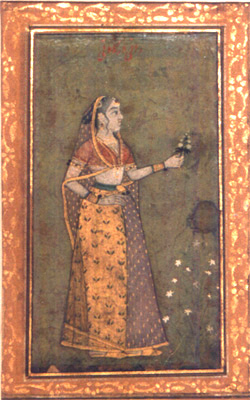
Rani Durgavati was the Queen regent of Gondwana in 1550-1564 A.D. She got married to King Dalpat Shah, the son of King Sangram Shah of Gondwana. She served as regent of Gondwana during the minority of her son, Vir Narayan, from 1550 until 1564. She is chiefly remembered for defending Gondwana against the Mughal Empire.

The history of human settlement in the western Indian state of Rajasthan dates back to about 100,000 years ago. Around 5000 to 2000 BCE many regions of Rajasthan belonged as the site of the Indus Valley Civilization. Kalibangan is the main Indus site of Rajasthan, here fire altars have been discovered, similar to those found at Lothal.

The history of Madhya Pradesh can be divided into three periods - the ancient period, the medieval period and modern period.

A ghoonghat is a headcovering or headscarf, worn primarily in the Indian subcontinent, by some married Hindu, Jain, and Sikh women to cover their heads, and often their faces. Generally aanchal or pallu, the loose end of a sari is pulled over the head and face to act as a ghoonghat. A dupatta is also commonly used as a ghoongat.

Abu'l-Fath Jalal-ud-din Muhammad Akbar, popularly known as Akbar the Great, and also as Akbar I, was the third Mughal emperor, who reigned from 1556 to 1605. Akbar succeeded his father, Humayun, under a regent, Bairam Khan, who helped the young emperor expand and consolidate Mughal domains in the Indian subcontinent.
Dodwad is a village in Belgaum district in the southern state of Karnataka, India.

Hinduism is the most followed Religion in India and nearly 84% of the total population of Karnataka follows Hinduism, as per 2011 Census of India. Several great empires and dynasties have ruled over Karnataka and many of them have contributed richly to the growth of Hinduism, its temple culture and social development. These developments have reinforced the "Householder tradition", which is of disciplined domesticity, though the saints who propagated Hinduism in the state and in the country were themselves ascetics. The Bhakti movement, of Hindu origin, is devoted to the worship of Shiva and Vishnu; it had a telling impact on the sociocultural ethos of Karnataka from the 12th century onwards.
The zenana or female portion of a Muslim house
{{cite news}}: CS1 maint: unfit URL (link)